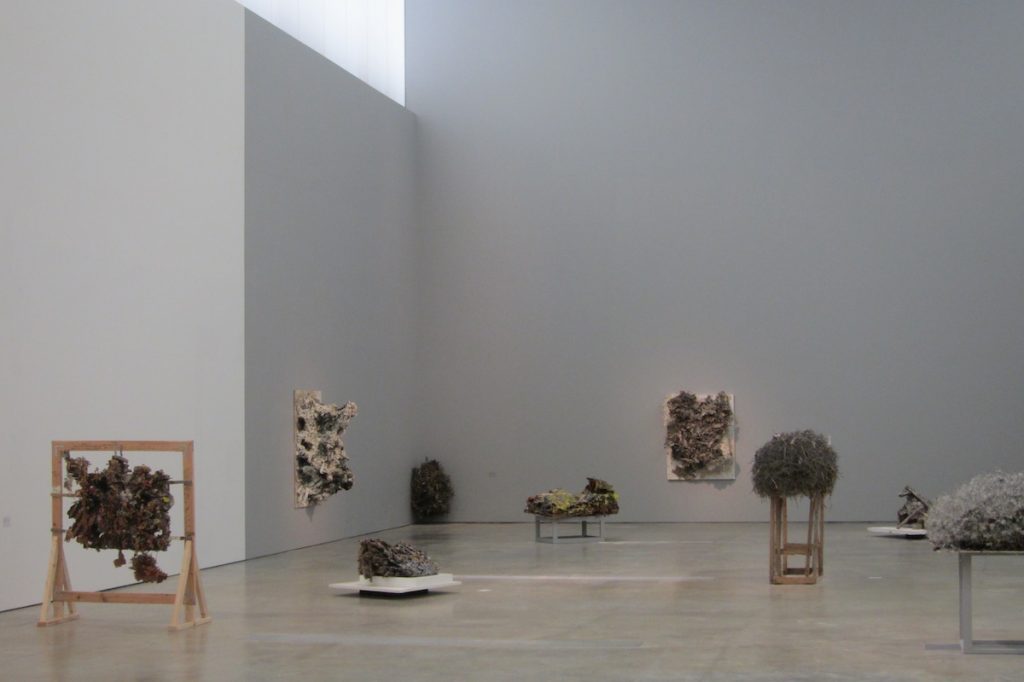Paul Mosse, What’s with the Apocalypse? at VISUAL
What’s with the Apocalypse? poses its question. Helpfully there’s a school, where glass cabinets hosting jarred specimens borrowed from the artist’s studio sit alongside open boxes where touch is actively encouraged. There is a separate space where commercial gallery pieces indicate the artist’s practice on a more manageable scale. And then there is the showroom or main gallery where the serious work resides. Typical of the works inside, Open Spaces (2007) and White Grid (2010) draw towards desolation as a sort of organic materialism, where in spite of the odds, life thrives. From first sight this body of work looks as though it has been made along intuitive lines, form following the artist as he works up numerous interacting layers to produce wall works and pieces for the floor. As these are largely made up of detritus and dusty shavings or loosened and regathered bits glued to form a solid, time also plays its part.
We all know that the image is flat. You only need do a quick online search and you will see it’s true. Flat images. We might blame the computer interface, in particular its necessity to merge image and surface. Imagine for a second polishing a semi-precious stone or piece of marble to reveal with your hand the hidden thread inside that stone. As the human mystery develops, consider again how it is that the artist’s hand matters in our digital age. If a painting or any other art-object can matter beyond being a vehicle for wealth or status, then its worth must be accounted for as something beyond our accepted knowledge. Certainly beyond tech know-how.
Of course a flat image, whatever its content, must accept our suspicions that it has something else going on behind its surface. While the digital image is routinely interfered with, still it remains flat. Standing to one side of Mosse’s work, we see metal skewers and ten inch screws which state clearly that some tinkering has helped produce the artist’s completed image. How can visual impact and three dimensional form be rendered cohesive? For much of these works all that’s needed is a lot of glue and dust.
It is important to remember that this is a retrospective, reflecting a career development over five decades. Back then television sets contained a green-coloured motherboard, somewhere between chipboard and a microchip processor. Anyone who has seen a motherboard might still recollect their own imaginings of utopian cityscapes; presented albeit in miniature, they spoke of the imaginative possibility of technology in its material form. If you were curious to see how a television set worked, you might be the sort to see such fantastical worlds. This manner of visual intelligence leads us to understand how Mosse’s work develops from the late 90’s into what we have come to learn is a digital age.
Yet it might actually be that the digital experience with which we are now so familiar only serves to enhance this particular body of work. Made up from layers of bits and pieces, time and again this installation reminds us that our pictures are really made from the inside out. At a time when the image operates in the world as both viral and suspect, Mosse’s works, while inherently dated, confess enquiry and curiosity concerning the material of man as much as the material of stuff. In his more recent works it can be seen that he is seeking to let go of the surface as a stable resolution, with works like Thin Wires (2017) expressing a core network of multiple charge where dendrites echo the crystalline formations embedded in some of his earlier pieces.
The question remains, What’s with the Apocalypse? In the face of a technological chase for spectacle and illusion, simply finding, sticking and building upon seem almost romantic, belonging to a past. It’s not yet clear where that leaves the viewer but the futuristic vantage point has long worn away. We look instead through nostalgic filters, as though to remember a future for never having been.


